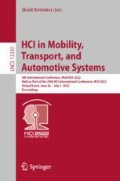Abstract
This study investigated the effect of age on driving behavior and provided a neurophysiological interpretation. Two age group of participants have driven on a 10-mile interstate highway on a driving simulator under different traffic density and driving mode. Driving performance, eye movement, brain activity, and subjective workload were measured. Results showed that age didn’t affect the driving performance or brain activity. But the subjective workload and eye movement were significantly different among the two age groups. Moreover, drivers’ subjective workload was not consistent with the eye movement. The study should provide insights to future studies about the effect of human factors in driving behavior.
Access this chapter
Tax calculation will be finalised at checkout
Purchases are for personal use only
References
World Health Organization: Road traffic injuries, 21 June 2021. https://www.who.int/news-room/fact-sheets/detail/road-traffic-injuries
Mueller, A.S., Trick, L.M.: Driving in fog: the effects of driving experience and visibility on speed compensation and hazard avoidance. Accid. Anal. Prev. 48, 472–479 (2012)
Bao, S., Wu, L., Yu, B., Sayer, J.R.: An examination of teen drivers’ car-following behavior under naturalistic driving conditions: with and without an advanced driving assistance system. Accid. Anal. Prev. 147, 1–7 (2020)
National Highway Traffic Safety Administration (NHTSA). Traffic Safety Facts 2019: Young Drivers (Report No. DOT HS 813 130). U.S. Department of Transportation, June 2021. https://crashstats.nhtsa.dot.gov/Api/Public/ViewPublication/813130externalicon
Simons-Morton, B., Lerner, N., Singer, J.: The observed effects of teenage passengers on the risky driving behavior of teenage drivers. Accid. Anal. Prev. 37(6), 973–982 (2005)
Konstantopoulos, P., Chapman, P., Crundall, D.: Driver’s visual attention as a function of driving experience and visibility. Using a driving simulator to explore drivers’ eye movements in day, night and rain driving. Accid. Anal. Prev. 42(3), 827–834 (2010)
Derrig, R.A., Sequi-Gomez, M., Abtahi, A., Liu, L.: The effect of population safety belt usage rates on motor vehicle-related fatalities. Accid. Anal. Prev. 34(1), 101–110 (2002)
Hijar, M., Carrillo, C., Flores, M., Anaya, R., Lopez, V.: Risk factors in highway traffic accidents: a case control study. Accid. Anal. Prev. 32(5), 703–709 (2000)
Norris, F.H., Matthews, B.A., Riad, J.K.: Characterological, situational, and behavioral risk factors for motor vehicle accidents: a prospective examination. Accid. Anal. Prev. 32(4), 505–515 (2000)
Zhang, J., Lindsay, J., Clarke, K., Robbins, G., Mao, Y.: Factors affecting the severity of motor vehicle traffic crashes involving elderly drivers in Ontario. Accid. Anal. Prev. 32(1), 117–125 (2000)
Hartwich, F., Beggiato, M., Krems, J.: Driving comfort, enjoyment and acceptance of automated driving – effects of drivers’ age and driving style familiarity. Ergonomics 61(8), 1017–1032 (2018)
Zhang, Q., Yang, X., Robert, L.: Drivers’ age and automated vehicle explanations. Sustainability 13(4), 1948 (2021)
Sportillo, D., Paljic, A., Ojeda, L.: On-road evaluation of autonomous driving training. In: 14th ACM/IEEE International Conference on Human-Robot Interaction (HRI), pp. 182–190. IEEE Press, Daegu (2019)
Wu, Y., et al.: Age-related differences in effects of non-driving related tasks on takeover performance in automated driving. J. Saf. Res. 72, 231–238 (2020)
Li, S., Blythe, P., Guo, W., Namdeo, A.: Investigating the effects of age and disengagement in driving on driver’s takeover control performance in highly automated vehicles. Transp. Plan. Technol. 42(5), 470–497 (2019)
Körber, M., Gold, C., Lechner, D., Bengler, K.: The influence of age on the take-over of vehicle control in highly automated driving. Transp. Res. F: Traffic Psychol. Behav. 39, 19–32 (2016)
Li, T., Zhao, R., Liu, Y., Li, Y., Li, G.: Evaluate the effect of age and driving experience on driving performance with automated vehicles. In: Stanton, N. (ed.) Advances in Human Aspects of Transportation, vol. 270, pp. 155–161. Springer, Cham (2021). https://doi.org/10.1007/978-3-030-80012-3_19
Yoshino, K., Oka, N., Yamamoto, K., Takahashi, H., Kato, T.: Functional brain imaging using near-infrared spectroscopy during actual driving on an expressway. Front. Hum. Neurosci. 7 (2013). https://doi.org/10.3389/fnhum.2013.00882
Unni, A., Ihme, K., Jipp, M., Rieger, J.W.: Assessing the driver’s current level of working memory load with high density functional near-infrared spectroscopy: a realistic driving simulator study. Front. Hum. Neurosci. 11 (2017). https://doi.org/10.3389/fnhum.2017.00167
Zhao, R., Liu, Y., Li, Y., Tokgoz, B.: An investigation of resilience in human driving and automatic driving in freight transportation system. In: IIE Annual Conference, pp. 974–979. Norcross (2021)
Liu, Y., Zhao, R., Li, T., Li, Y.: An investigation of the impact of autonomous driving on driving behavior in traffic jam. In: IIE Annual Conference, pp. 986–991. Norcross (2021)
Acknowledgements
This research was partially supported by the Center for Advances in Port Management (CAPM) at Lamar University. Any opinions, findings, and conclusions or recommendations expressed in this material are those of the authors and do not necessarily reflect the views of the CAPM.
Author information
Authors and Affiliations
Corresponding author
Editor information
Editors and Affiliations
Rights and permissions
Copyright information
© 2022 The Author(s), under exclusive license to Springer Nature Switzerland AG
About this paper
Cite this paper
Li, T., Zhao, R., Liu, Y., Liu, X., Li, Y. (2022). Effect of Age on Driving Behavior and a Neurophysiological Interpretation. In: Krömker, H. (eds) HCI in Mobility, Transport, and Automotive Systems. HCII 2022. Lecture Notes in Computer Science, vol 13335. Springer, Cham. https://doi.org/10.1007/978-3-031-04987-3_12
Download citation
DOI: https://doi.org/10.1007/978-3-031-04987-3_12
Published:
Publisher Name: Springer, Cham
Print ISBN: 978-3-031-04986-6
Online ISBN: 978-3-031-04987-3
eBook Packages: Computer ScienceComputer Science (R0)

